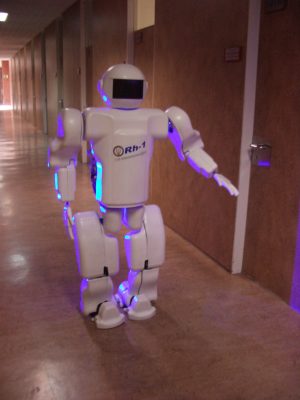The global objective of the Rh-1 project is the redesign of the humanoid robot RH-0, developed in the previous project, in order to be able to perform the cooperative tasks with humans in domestic or office environments. The Rh-0 robot, first national human-like robot with 21 DOF and with stable gait, must be making lighter by using new actuators? technology based on the torque motors. This approach will expect the weight reduction of about 20%. In order to increase the actuators? efficiency and drastically reduces the wires, the CanBus drivers will be used. Other mechatronical objective is the development of the human like hands for object manipulation. Their main advantages are the adaptation to the different object?s geometry and to be driven by only one motor.
On the other hand, the Rh-1 robot must be equipped with powerful sensorial system. Firstly, the robot needs sensors for dynamically stable gait by using the pressure sensors in the feet of the robot. In this way the real ZMP is computed in real-time. Another feedback system will base on the head sensors: vision system, telemeter laser and a set of directional microphones. Using these systems it will be possible to perform the human-humanoid interaction in active, bilateral and multimodal ways. The new global control system based on the distributed architecture will need. This will permit the real time computation of the robot?s dynamics model based on the simplified 3D inverted pendulum model by real ZMP feedback.
The Rh-1 robot will be able to perform some tasks in an autonomous way such as dynamic walking, object transportation, moving to the sound or image sources, etc. Some of these tasks will need interaction with the environment and/or humans: taking books, handshaking people, close/open the door, etc. This cooperation may be in some situation active without any specific command. The robot?s communications will perform using wireless HMI based on the speech recognition by PDA technology. The robot can be also teleoperated by low or medium levels commands (fold up the knee, extend the arm, turn to the left, etc.). For the final tests the domestic demonstrator (room with common furniture) is proposed in order to check the humanoid robot in cooperative tasks.

